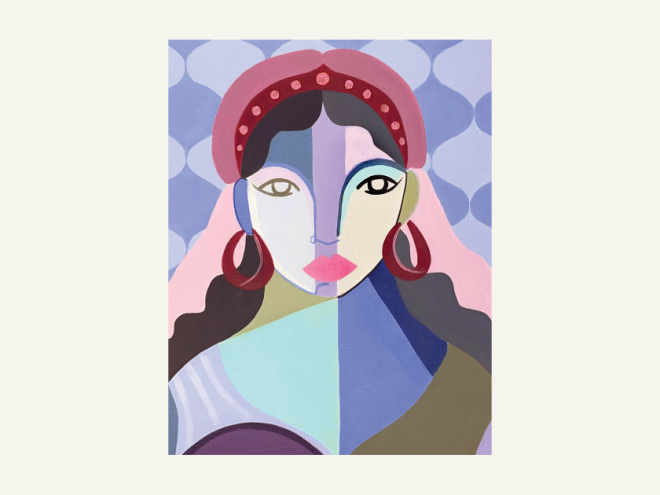
A group of boys on the steps of The Forward building who have just received copies of the newspaper, 1913. Photo by Lewis Wickes Hines
In 1918, a young writer named Jacob Glatstein, who was then a law student at NYU, submitted poetry to an anarchist Yiddish newspaper called the Fraye Arbeter Shtime (Free Voice of Labor). The paper’s editor rejected his poems. A few weeks later, he submitted the poems under the name Clara Blum, and the periodical eagerly accepted his work for publication. Similarly, in 1920, B. Z. Goldberg, a graduate student at Columbia, began publishing articles about love and relationships under the name Ida Brener in the intellectual, non-partisan Yiddish daily the Tog (The Day). Although the editors of the newspaper had described Goldberg’s previous articles on psychology and religion — published under his own name — as too “highbrow,” they did not express similar reservations about the pieces he published as Ida Brener.
In retrospect, these authors described their decisions to write under female pseudonyms as their method of gaining entry into the world of the American Yiddish press. They argued that Yiddish newspapers were eager to publish work by women — which editors and publishers purportedly viewed as more “popular,” more driven by human interest, and more likely to sell papers. But these origin stories belied the difficulties that female writers faced in forging careers in the Yiddish press. Indeed, in the American Yiddish publishing sphere, writing content that was seen as appealing to women readers, or writing material carrying a female byline, was crucial to the career development of writers. But it was especially advantageous to authors who were men.
_______
I came to history through my passion for archives. So part of my process of deciding on a research paper topic during my first year of graduate school was exploring the finding aids (guides outlining the contents of archival collections) of various collections housed at local libraries in Philadelphia. I hoped my findings would give me a sense of how the resources available to me might shape my development as a scholar, and ultimately the questions I would be asking about Jewish history and culture going forward in my studies.
When I started looking through the collections house at the University of Pennsylvania’s libraries, I came across the papers of B. Z. Goldberg, who was a prominent American Yiddish journalist and the son-in-law of famed author Sholem Aleichem. There was a brief biographical note about Goldberg that especially piqued my interest. About halfway through this note, there was a section that described how Goldberg got his start in Yiddish journalism writing under a female pseudonym:
Wishing to write for the Yiddish [newspaper] ‘the Day,’ but being told by the editor that he didn’t have the popular stuff the newspaper needed, BZG wrote under his secretary’s name a popular feature under the title ‘A Diary of a Young Woman.’ Edlin, the editor, didn’t believe it was the secretary, but published the articles anyway. They were an instantaneous success, and ran for a number of months. When the identity of the real author was revealed, Goldberg became a correspondent of ‘the Day’ and a permanent member of the staff.[1]
This biographical note was adapted from an essay by Goldberg himself, and, like many figures associated with the Yiddish press, he was not always a reliable narrator about his life. I came to find out later in my research process that there are pieces of misleading information in this paragraph, which I would come to explore in detail in my book, A Revolution in Type.
Nevertheless, I was immediately struck by the narrative put forth in this note — how it suggested that only by masquerading as a woman could Goldberg gain a foothold into the American Yiddish press. I found the repetition of the word “popular” particularly interesting, suggesting to me that it was not only the content that Goldberg submitted under a female pseudonym that the editor viewed as “popular” but also that there was some sense that writing by women (or in this case, a man pretending to be a woman) was seen as more popular or commercially viable in and of itself in the American Yiddish journalistic sphere in the early 1920s.
I was immediately struck by the narrative put forth in this note — how it suggested that only by masquerading as a woman could Goldberg gain a foothold into the American Yiddish press.
This narrative sparked questions for me: What led Goldberg to conflate the editor’s desire for “popular” writing with writing by, for, or about women? And was this part of a broader pattern within the Yiddish press or just a strange, interesting case study?
In the following weeks and months, I delved into a variety of first-hand accounts of the American Yiddish press in the early twentieth century from the perspectives of writers, editors, and readers. I soon found out that rumors were rampant that many writers, especially young men attempting to make an initial entry into the world of the American Yiddish press, were deciding, just like Goldberg, to submit their manuscripts to major American Yiddish newspapers under female pseudonyms in order to increase their chances of publication. As Yiddish newspapers were the prime venue for literature, as well as journalism, these rumors discussed submissions in a variety of genres, including articles, fiction, and poetry.
In his history of the American Yiddish press, for example, journalist Joseph Chaikin described this as a common phenomenon in poetry published in the Yiddish press as well. Here are his descriptions of how this played out in one prominent newspaper:
“Countless anecdotes have circulated among writers about their experiences with [the newspaper’s editor]…literally dozens of poets published poems under women’s names, which under their own names had been rejected.”
In Chaikin’s assessment, this reflected the editor’s general desire to feature female voices, but also the different standards used to judge work by men and by women. He asserted that the editor would reject certain author’s poems outright, but went so far as to say:
A few weeks later if he should receive the same poems, signed with a female name, he would not only receive them as eagerly as a precious gem, but also reprimand other writers: ‘you should learn to write poetry from her.’[2]
It turns out that Chaikin’s descriptions of “countless” men writing under female pseudonyms were exaggerations. But there are several traceable cases of men writing under female pseudonyms in the American Yiddish press that would eventually become prominent figures in Jewish culture. Moreover, this phenomenon was not actually limited only to the 1910s and 1920s, but instead was a phenomenon that occurred throughout the history of the Yiddish press in America. Moreover, what men decided to write under female pseudonyms, and how they described their decisions to do so, changed significantly over time, in ways that trace the development of the American Yiddish publishing sphere and its changing relationship to American popular culture and to transnational Jewish culture.
This brief description by Goldberg thus sparked my interest in exploring a broader research project investigating the ways that gender is woven into the foundations of American Yiddish journalism.
[1] “ARC MS1 — Ben-Zion Goldberg Papers (Benjamin Waife)” accessed November 10, 2023. https://web.archive.org/web/20220806022415/https://www.library.upenn.edu/collections/special-notable/single/arc-ms1-ben-zion-goldberg-papers-benjamin-waife; BZG Biography,” p. 2, [undated]; Ben-Zion Goldberg Papers (Benjamin Waife); ARC MS1; Box 72; Folder: “Biography B.Z.G.”; Katz Center for Advanced Judaic Studies, University of Pennsylvania.
[2] Joseph Chaikin, Yidishe bleter in amerike (New York: M. Shklarski, 1946), 258 – 9.
Ayelet Brinn is the Philip D. Feltman Assistant Professor of Modern Jewish History in the Departments of Judaic Studies and History at the University of Hartford.



